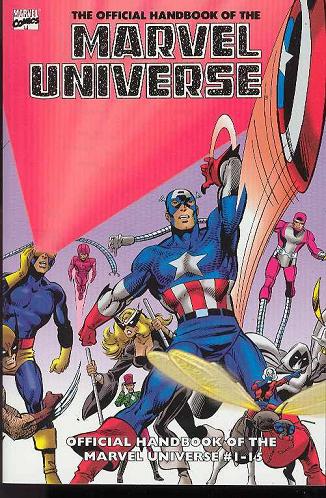
Essential Official Handbook of the Marvel Universe vol. 1
Mark Gruenwald, Peter Sanderson, Eliot R. Brown and friends
Reprints: Official Handbook of the Marvel Universe Vol 1, #1-15 (January 1983 – May 1984)
Get this for: hardcore nerding — three stars
Okay, I’ll admit it, I’ve always liked The Official Handbook of the Marvel Universe far more than its DC Comics equivalent, Who’s Who in the DC Universe, largely because the former was far geekier and willing to actually explain things, while Who’s Who was always a bit poofaced. You’d never have a “Book of Weapons, Hardware, and Paraphernalia” in Who’s Who, but it’s here in Essential Official Handbook of the Marvel Universe vol. 1, a symbol of the nerd power of three men: Mark Gruenwald, Peter Sanderson and Eliot R. Brown.
OHOTMU, to give it its official acronym was a Gruenwald project, the first series running in 1983-1984, allegedly started not just because he was the kind of fan turned professional who actually cared about how much tonnes the Thing could bench press, but also because DC was going to bring out Who’s Who as part of their Fifty years anniversary celebrations in 1985. Back then the two companies were insanely competitive and especially Marvel, then with Jim Shooter as editor-in-chief seemed keen to scoop its rival. Personally I think this series would’ve been published even without this rivalry. Gruenwald was not the only one interested in a handbook showcasing all the well known and not so well known heroes and villains in the Marvel Universe. In the early eighties a whole generation of Marvel Zombies had grown up with Marvel and kept reading them when grown up, getting obsessed with the minutia of a shared universe. Today they would be browsing Tvtropes, back then they read OHOTMU.
The first series of OHOTMU collected here ran for fifteen issues, with the first twelve going from A to Z through the Marvel Universe, two Books of the Death and one Book of Weapons, Hardware, and Paraphernalia. Each entry is between half to two pages long, has a nice picture of the featured character posing for the camera, their vital statistics, a longish potted history of their appearance and some discussion of their powers. Gruenwald and co are not afraid to make things up if the original comics weren’t clear. Artwise, most artists then working for Marvel contributed, with e.g. John Byrne handling the characters from the titles he was the artist on.
A later version of the handbook estimated that there were roughly 2-3,000 or so significant characters in the Marvel Universe, those with two appearances or more and/or who did something interesting. A limited series of fifteen issues, though without advertising, has limited room and can’t cover them all, so it’s interesting who was picked. All the familiar faces are there of course: an Iron Man or Scarlet Witch will always have a place in such a series, but a villian like Belladona (seen in a few Spider-Man stories) or a group like the Champions of Xandar (featured in a Fantastic Four story, not so much. Reading a series like this then gives an interesting look in the Marvel Universe of almost thirty years ago. Not just by who gets featured, but also by who gets half a page, a full page or is important enough for two….
Obviously most of the information here is long out of date, but that’s not the point. It’s an interesting cross section of the Marvel U. at a certain point in time and for me part of its appeal also is that this is the Marvel I grew up with. You won’t miss much by not buying this volume, but to me this is indeed an essential volume.